There is a very good discussion on finding the nearest neighbors of a point among points using scipy.spatial.Delaunay here: How to find all neighbors of a given point in a delaunay triangulation using scipy.spatial.Delaunay?
I followed the answers, but I have difficulty when the symmetry of the configuration is high. Here is my code:
import numpy as np
from matplotlib import pyplot as plt
from scipy.spatial import Delaunay
##########################################################
# Gets a Delaunay triangulations and returns the
# nearest neighbor points for each point
def find_neighbors(tri):
l = tri.vertex_neighbor_vertices
neib = []
for i in range(len(l[0])-1):
neib.append(list(l[1][l[0][i]:l[0][i+1]]))
return neib
# Create a square lattice
t1 = np.array([1,0])
t2 = np.array([0,1])
n = 6
lattice = np.zeros((n**2,2))
for i in range(n):
for j in range(n):
lattice[i*n + j] = i* t1 + j * t2
tri = Delaunay(lattice)
Neib = find_neighbors (tri)
pindex = 20
plt.title("particle index: 20")
plt.triplot(lattice[:,0], lattice[:,1], tri.simplices.copy(),"c--")
plt.plot(lattice[:,0], lattice[:,1], 'go')
plt.plot(lattice[pindex,0], lattice[pindex,1], 'bo')
plt.plot([lattice[i,0] for i in Neib[pindex]],[lattice[i,1] for i in Neib[pindex]], 'ro')
plt.show()
pindex = 21
plt.title("particle index: 21")
plt.triplot(lattice[:,0], lattice[:,1], tri.simplices.copy(),"c--")
plt.plot(lattice[:,0], lattice[:,1], 'go')
plt.plot(lattice[pindex,0], lattice[pindex,1], 'bo')
plt.plot([lattice[i,0] for i in Neib[pindex]], [lattice[i,1] for i in Neib[pindex]], 'ro')
plt.show()
from scipy.spatial import Voronoi, voronoi_plot_2d
vor = Voronoi(lattice)
fig = voronoi_plot_2d(vor)
plt.show()
and the results are below. As you see for two points with identical symmetry I get a different number of neighbors, due to the way scipy does Delaunay triangulation. Is there any code in python to obtain the neighbors through scipy.spatial.Voronoi instead? I appreciate your help.
Here is the link to the images. My reputation is less than 10 and I cannot post images right now. (alternatively, you can run the code to get the same results)
index 20
https://i.ibb.co/9bQQqmT/download.png
index 21
https://i.ibb.co/pfw5hsG/download-1.png
Voronoi diagram
